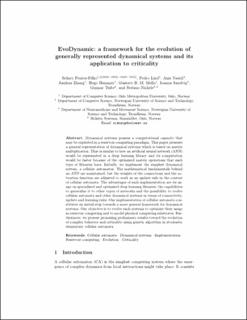EvoDynamic: A Framework for the Evolution of Generally Represented Dynamical Systems and Its Application to Criticality
Pontes-Filho, Sidney; Lind, Pedro; Yazidi, Anis; Zhang, Jianhua; Hammer, Hugo Lewi; Mello, Gustavo; Sandvig, Ioanna; Tufte, Gunnar; Nichele, Stefano
Chapter
Accepted version
Permanent lenke
https://hdl.handle.net/11250/2724664Utgivelsesdato
2020Metadata
Vis full innførselSamlinger
Originalversjon
https://doi.org/10.1007/978-3-030-43722-0_9Sammendrag
Dynamical systems possess a computational capacity that may be exploited in a reservoir computing paradigm. This paper presents a general representation of dynamical systems which is based on matrix multiplication. That is similar to how an artificial neural network (ANN) is represented in a deep learning library and its computation can be faster because of the optimized matrix operations that such type of libraries have. Initially, we implement the simplest dynamical system, a cellular automaton. The mathematical fundamentals behind an ANN are maintained, but the weights of the connections and the activation function are adjusted to work as an update rule in the context of cellular automata. The advantages of such implementation are its usage on specialized and optimized deep learning libraries, the capabilities to generalize it to other types of networks and the possibility to evolve cellular automata and other dynamical systems in terms of connectivity, update and learning rules. Our implementation of cellular automata constitutes an initial step towards a more general framework for dynamical systems. Our objective is to evolve such systems to optimize their usage in reservoir computing and to model physical computing substrates. Furthermore, we present promising preliminary results toward the evolution of complex behavior and criticality using genetic algorithm in stochastic elementary cellular automata.
